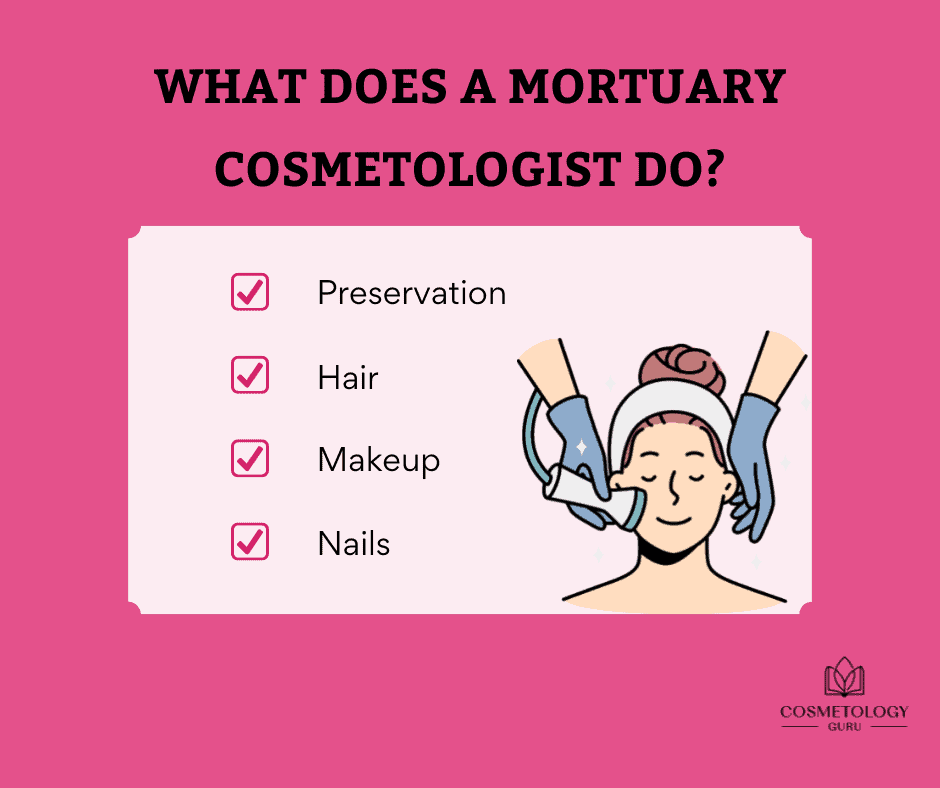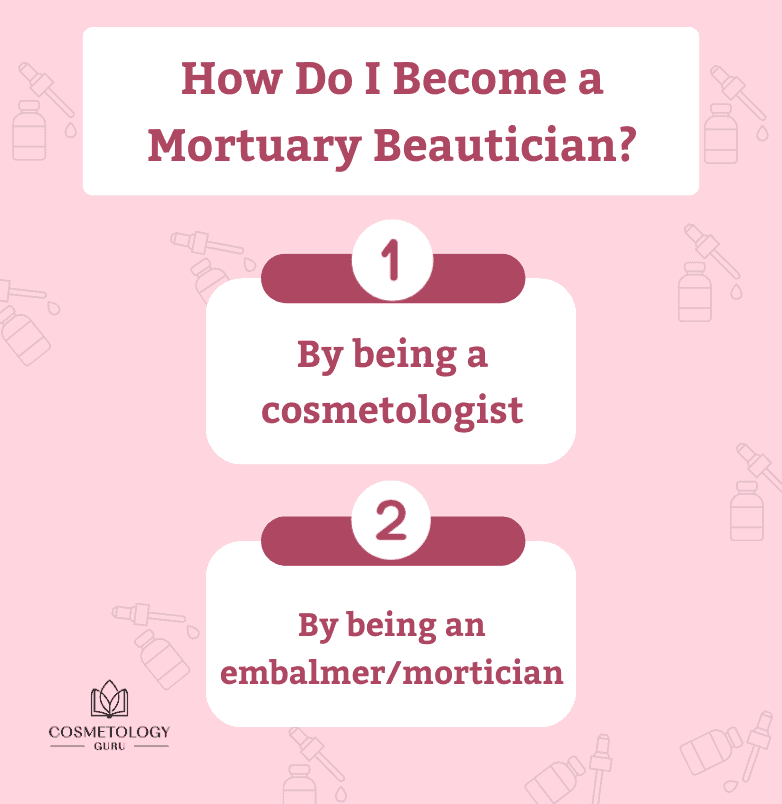For some, applying makeup to a dead body seems, well, creepy. And it’s easy to underestimate the importance of the job. For those who have just lost a loved one, seeing them as they once looked one last time can help provide much-needed closure.
You can become a mortuary cosmetologist by either going through beauty school and getting a cosmetology license or by becoming a licensed embalmer. Either way, you’ll be responsible for doing hair, makeup, and nails to prepare the deceased for funeral services.
What Is a Mortuary Cosmetologist?
Funeral cosmetology – also known as desairology – is when a specially licensed person prepares a decedent for funeral and burial services. A mortuary cosmetologist will generally alter a person’s hair, face, and even nails so that the person is appropriate for viewing.
The main difference between a regular cosmetologist and a mortuary beautician is that you won’t be making them up to beautify them. Your goal will be to make them look how they naturally did when they were alive.
You will also be interacting very closely with the grieving family. The best mortuary cosmetologists aren’t just experts at putting on makeup and styling hair – they’re empathetic.
Your clients are going to be sad, and rightfully so. They are usually the people who were closest to the one who just passed away, and since most funerals take place within a week or two of the person’s death, the wound will still be fresh.
That’s why it’s of the utmost importance to be patient and compassionate. You will need to fulfill the family’s wishes as to how they want their loved one to look, and getting that information might be a slow and tearful process.
A mortuary cosmetologist also acts as a comforter, and it’s often the most rewarding part of the job. You will be the one responsible for how someone views their spouse, parent, or even child for the last time.
How they see their loved one for the last time is a memory they won’t soon forget. Your job is to make them seem peaceful and at rest – as if they were simply asleep. If you can succeed at that, the deceased’s family and friends will be one step closer in finding closure.
What Does a Mortuary Cosmetologist Do?
As previously stated, a mortuary cosmetologist styles hair, applies makeup, and paints nails on a deceased body in an attempt to make them look as if they were simply asleep. But what does that process actually look like?

Preservation
For starters, the body is picked up from the location of death and brought to a funeral home or mortuary. From there, the body is then bathed and disinfected.
In most states, the body has to be either cremated/buried within 48 hours, or needs to be preserved. The most common methods are refrigeration or embalming. Embalming is the preservation method of choice for those who will be having a wake, visitation, and/or open-casket funeral.
The process of embalming is simple, and is something you might need to know how to do, depending on how you choose to enter into the field of desairology.
To put it in the least graphic way possible, bodily fluids are removed (usually through the veins with a machine), and then embalming fluid is pushed through the circulatory system via the arteries.
Embalming fluid is a mixture of formaldehyde, water, a bunch of other hard-to-pronounce chemicals, and dye. Besides preservation, the goal is to give the body a more lifelike color. Organs and body cavities are also preserved using a relatively similar process.
Depending on your licensing and job position, you may or may not be required to take part in that process.
Hair
Once the body has been thoroughly disinfected and preserved, the cosmetic process can begin.
The family of the deceased will have given you or the funeral home you’re working with a “memory photo.” This is your reference photo for how the person looked while they were still alive, and how the family wants to remember them.
Sometimes, the memory photo makes it hard to determine how the person looked. This could be because the family chose a photo from many years prior to the loved one’s death, or maybe the photo is old and grainy. In that case, you could either ask for a more recent picture, or do your best with what you’ve been given.
The family will also tell you how they want their loved one’s hair styled. They could want it natural, how it was most commonly styled while they were still living, or how it looks in the reference photo.
Styling the hair of a deceased person isn’t easy, because most likely you’ll be styling the hair when the person is lying down. Not to mention, you will have to shampoo, condition, and comb it prior to styling.
Regardless of the request or the difficulties, it will be your job to make sure you style the hair as accurately as possible.
Makeup
When it comes to a preserved body, makeup is going to act a little differently than it normally would. And the reason for this is the embalming process.
For one, the chemicals involved in preservation make the skin firm, almost hard. That means that blending makeup is going to be more difficult. Even if you can blend it well, you run the risk of the face looking cakey, streaked, and unnatural.
If you can, airbrushing is the way to go. You will be able to get streak-free, even application using less makeup, meaning it won’t be caked on. Remember, unless the family requests otherwise, the goal is to make them look natural, not glamorized.
A mortuary cosmetologist will also need to focus heavily on the lips. This is because, as with the skin, embalming drastically changes the appearance of the lips. It makes them appear thin, almost nonexistent.
Lip liner, lipstick, and lipgloss will need to be masterfully used to reconstruct the natural appearance of the person’s lips.
When applying the makeup, it’s important to pay close attention to what the family has requested. Did the person wear a lot of makeup before death? They might request eyeliner or even eyeshadow. Did the person hardly ever wear makeup? You might want to use as little as possible.
Nails
A desairologist will also often paint the nails of a deceased person before viewings, burials, and funeral services.
This is done because, after someone passes away, their nails turn a pale grey or white shade, which isn’t common for living people. Plus, in the casket, their hands will be visibly placed on their chest, and not painting them could ruin the whole “peacefully asleep” aesthetic.
Most mortuary beauticians simply swipe a neutral shade over the nails. But again, this is all at the request of the family.
It’s important to remember, also, to be sensitive to the family’s religious and/or cultural customs that may impact what you can and can’t do. It may also affect what products you can and can’t use during this process.
How Do I Become a Mortuary Beautician?
You can enter into the field of desairology in one of two ways. Look at the image below:

Each way has its own set of requirements and benefits. Currently, there is no standard licensing for mortuary cosmetology on its own as a separate field.
Taking the cosmetology route
If you want to be a cosmetologist with the option of working with the deceased on occasion, you could consider beauty school. Beauty school is the faster of the two options, as it usually only requires one to two years of schooling.
First, you would get either a high school diploma or get your GED (if you haven’t already). Then, you need to either get an associates degree in cosmetology or complete a cosmetology training program and receive a certificate. Remember, different states have different requirements.
After that, you’re eligible to take your state’s cosmetology licensing exam. Once you pass that and become a state-certified cosmetologist, you can practice desairology as well!
Taking the mortician route
If you want to be involved in the whole process and not just the makeup aspect, you could become an embalmer. Becoming an embalmer usually takes two to four years of schooling.
Becoming an embalmer requires a degree in mortuary science as well as special licensing. You can take mortuary science courses in most universities. However, there are dedicated mortuary science colleges where your main focus will be on preparing you for this specific field.
Depending on your state, you will either get a license that allows you to be a mortician and an embalmer, or those might be separated into two licenses. The only one required for desairology is the embalmer’s license.
An embalmer is trained and certified to preserve bodies and are normally hired by funeral homes to do just that. In most cases, an embalmer is the one who does the cosmetics on the deceased as well.
How To Get a Job as a Mortuary Cosmetologist
How to get hired as a mortuary cosmetologist is also dependent upon the route you took to enter into the profession.
If you became an embalmer, you can expect to get hired as a full–time employee at a funeral home near you, so long as the position is open. And if you live in a rural area, you might have to expand your search radius to find a funeral home that’s hiring.
You can also apprentice under a senior embalmer or mortician, which can increase your chances of getting hired by that funeral home somewhere down the road. However, apprenticeships pay little to nothing, so it ultimately depends on your personal situation.
If you became a cosmetologist and went through beauty school, your opportunities in desairology will be more limited.
One big reason for that is that only larger funeral homes in metropolitan areas can afford to hire a specified cosmetologist. In smaller homes or more rural areas, it will generally be the embalmer or mortician handling those duties.
But don’t fear, you can still enter into the business! It might just take a little extra work.
Know how Female mortician Miranda Robinson is depicting “Embalming” as a form of art.
Getting hired as a mortuary beautician
If you’re a cosmetologist, look up funeral homes near you that you would be willing to work with. Then, you can connect with them and reach out to offer your services on an as-needed basis.
You can also check for job postings online, either on the funeral home’s website directly, or on a job search site, like Indeed.
It will help your chances of getting hired if you have a portfolio of your previous work. Even if you haven’t worked on the dead yet, photos of your work on the living will generally suffice.
It’s worth noting that most mortuary cosmetologists who enter the profession by beauty school end up working as independent contractors in this field, but that’s not always a bad thing. It all depends on your preference!
Not to mention that, after you’ve established a steady relationship with a funeral home and proven your quality of work and expertise, you can become their designated makeup artist. That can help provide you a steadier stream of work in the field.
How Much Does a Mortuary Cosmetologist Make per Year?
How much you can earn per year in this field is also mainly dependent upon the way in which you entered the industry.
For example, if you’re only a cosmetologist with no further licensing, you will most likely be doing jobs in conjunction with your standard cosmetology work.
Thus, you can expect to earn what an average cosmetologist earns: about $45,825 per year. It’s important to note that this price can go up if you specialize in the reconstruction of disfigurement, as you can charge more for your desairologist services.
On the other hand, if you’re doing mortuary cosmetology as a natural aspect of being a mortician, you can expect to earn an average of $54,911 per year.
Either way, being a mortuary cosmetologist can be a very rewarding career both financially and emotionally.
Related Reads
- Life After Cosmetology School: How To Start Your Career As A Newly Licensed Cosmetologist
- What’s The Difference Between A Cosmetologist And An Esthetician?
- Beauty Salon Services Every Cosmetologist Should Know About
Navigating the insurance landscape can be tricky for cosmetologists, but finding the right partner can safeguard your career against unforeseen events.


